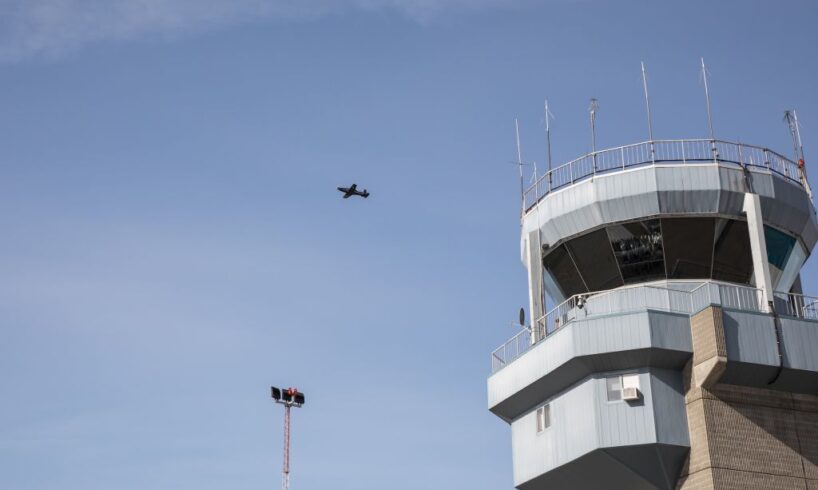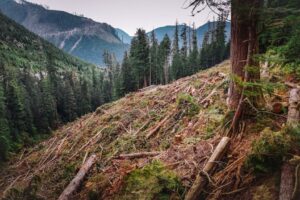
Internal studies about contamination at a Saskatchewan military base found evidence of dust contaminated with PFAS — per- and polyfluoroalkyl substances, often referred to as forever chemicals — and experts who reviewed the data say it could pose a risk to people who work there.
“The sampling results indicate that PFAS [are] present in dust,” the March 2025 study, obtained by The Narwhal, concluded. When The Narwhal asked independent experts to review the findings, one noted the concentrations were in some cases “very high,” while another flagged that several volatile organic compounds associated with increased cancer risk are also present.
The study looked at a building known as Building 143 at CFB Moose Jaw, home of the Snowbirds, where employees have been ringing alarm bells about what they say are concerning numbers of illnesses and deaths among employees and military members on base.
It took place about three months after three employees of the Moose Jaw base went to Ottawa to speak about cancers, infertility, neurological disorders and untimely deaths of colleagues — at a public hearing of the Standing Committee on National Defence in December 2024. At least one of these employees has since had to go on long-term disability insurance, and another submitted an official refusal to work in Building 143 and the base at large for fear of how it is impacting her health.
In response to employee concerns, the Department of National Defence initiated a study of contamination at CFB Moose Jaw earlier this year. The department asserts there is “no evidence” that buildings on the base are unsafe. But experts who reviewed the study told The Narwhal that’s not true. Photo: Amber Bracken / The Narwhal
The concerns of the employees, National Defence told The Narwhal, eventually led the department to initiate the study published in March 2025, in what they called a “a transparent and evidence-based analysis to address the concerns expressed by some employees,” undertaken out “of an abundance of caution.”
The Department of National Defence told The Narwhal it is “committed to the health and safety of personnel and surrounding communities, as well as to responsible environmental management.”
“As part of this commitment, we conduct regular monitoring programs at bases and wings to assess environmental conditions and identify potential concerns,” the department shared, adding the reports are now available for all service members to review.
The department asserts it has “no concerns about the safety of this particular building at this time,” given there is “no evidence to suggest that 15 Wing buildings are unsafe or unfit for occupancy.” (15 Wing refers to the centre of the Royal Canadian Air Force activity at the Moose Jaw base.) But some experts disagree.
PFAS are linked to cancers, infertility and more
Contamination on federal sites is an issue across Canada. There are thousands of contaminated sites listed on the federal contaminated sites inventory. PFAS are found or suspected on more than 100 of them, in large part from firefighting foam National Defence used to train military and civilian firefighters across Canada from the 1970s to the early 2010s.
At CFB Moose Jaw, employees have been concerned for years; they’ve compiled a list of nearly 200 illnesses and dozens of obituaries of colleagues. One building in particular, where at least five women who worked together had emergency hysterectomies, has been at the top of mind — Building 143. It’s a central building housing offices and medical centres for personnel where internal studies confirmed the presence of PFAS.
Here, employees told The Narwhal they were constantly wiping an unusual amount of dust off their coffee mugs and desks daily, and some say they smelled chemical smells wafting past their desks at various times of day.
Snowbird veteran Erin Zimmerman is on disability leave with an early onset diagnosis of Parkinson’s disease. She’s pushing for answers about contamination at the Moose Jaw base where she worked, and she’s sharing her findings with other current and former employees. Photo: Amber Bracken / The Narwhal
The United States Environmental Protection Agency lists potential health risks of exposure to PFAS, including reproductive problems like infertility, developmental effects in children, increased risk of prostate, kidney and testicular cancers and weakening of the body’s immune system, including reduced vaccine response. The Canadian government says PFAS can be transferred through the placenta during pregnancy and infants and children can be exposed through ingestion of human milk.
Other carcinogens present at Building 143 are a risk no matter what the level: expert
The internal documents obtained by The Narwhal also show “airborne concentrations of several [volatile organic compounds]” — also known as VOCs. Some are associated with increased cancer risk, said Christine Oliver, a professor at the Dalla Lana School of Public Health at the University of Toronto, who reviewed the documents and has studied clusters of illnesses arising from contaminated workplaces for decades.
The carcinogens found in the studies include trichloroethylene (an industrial metal-degreaser), benzene (found in gasoline) and polycyclic aromatic hydrocarbons, or PAHs, which are produced by incomplete burning of coal, crude oil and gasoline. The Environmental Protection Agency says people can be exposed to mixtures of PAHs by breathing air contaminated with vehicle exhaust, or fumes from asphalt roads. The agency says several individual PAHs and some specific mixtures of PAHs are considered to be cancer-causing.
“That airborne concentrations of the [Polycyclic Aromatic Hydrocarbons] are below the [Occupational Exposure Limit] does not mean that they are harmless,” Oliver said. “For carcinogens, the existence of a threshold — i.e., a dose below which there is no cancer risk — is rare. I can think of none.”
The Department of National Defence told The Narwhal that Building 143 is not a suspected contaminated site, and there is “no subsequent environmental sampling required.”
The department did not respond to The Narwhal’s questions for responses to experts who believe the contracted reports are showing concerning levels of contaminants — enough to warrant exposure and health concerns in employees.
Contamination data at other bases found to be ‘incorrect’ and ‘biased’
Oliver is not the only expert who had concerns about the findings, though.
Meg Sears is chair of the organization Prevent Cancer Now, whose board is composed of physicians, environmental advocates and at least one veteran. For decades, she has been working to help veterans in Gagetown, N.B., receive accurate data about their exposure to Agent Orange — the infamous herbicide mixture used by the American army during the Vietnam War — which was tested on-base in the 1960s.
Many military sites across Canada are known to be contaminated with pollutants associated with cancer, infertility and other human health impacts. Photo: Amber Bracken / The Narwhal
Sears calls the findings of the federal government studies done at Gagetown “flimsy” — an opinion backed up last year by a commission in Maine, which looked into the health of National Guard members who had trained at the New Brunswick base and called Canada’s data “incorrect” and “biased.” So, despite the assurances provided to CFB Moose Jaw employees by their superiors, Sears is not convinced.
“If there is some kind of selective choice of analyses being done or types of sampling being done, it’s not the first time that the Government of Canada has chosen to do these kinds of reports in perhaps not the most informing way,” Sears said, pointing to the fact that testing the building’s water supply, groundwater and soil from below the interior footprint of the building was “excluded from the scope of work” by the Department of National Defence.
The Department of National Defence told The Narwhal that the base’s drinking water, including Building 143’s, is supplied by the City of Moose Jaw, adding: “Drinking water is tested at all [Canadian Armed Forces] locations on a regular schedule,” and that current results don’t indicate any of the 25 polyfluoroalkyl substances (PFAS) substances listed by Health Canada.
“The question for this study is, ‘What is the exposure to the people who are carefully walking around and just going straight to their work at their desk,” Sears said. “And what this is showing is that, even within the building, there is significant exposure to PFAS just from the dust.”
“Certainly there are significant quantities of PFAS there,” Sears said, adding: “The pattern is indicative of contamination from the Air Force.”
Higher PFAS levels than soil beside chemical manufacturers: expert
When asked to review the studies, Sébastien Sauvé, a professor of environmental chemistry at Université de Montréal, who was called to the standing committee meeting late last year, also saw reasons for concern.
“Some of those concentrations are very high,” he explained. He said some of the dust samples’ PFAS values are higher than what he’s seen in contaminated soils right beside a PFAS chemical manufacturer.
Sauvé is no stranger to contaminated National Defence bases; in his home province of Quebec, he discovered that PFAS had spread from a contaminated military base in Bagotville, Que., to drinking water wells up to 10 kilometres away.
A spokesperson from the Department of National Defence told The Narwhal that an indoor air assessment and hazardous substance assessment of Building 143 “did not identify any health issues,” and that “National Defence has no concerns about any other buildings across the base.”
A dozen former and current employees of CFB Moose Jaw attended a meeting in May 2025 to learn more about contamination at their workplace. Lynn Point, front, was one of the attendees. She believes her breast cancer is related to contamination at the base. Photo: Amber Bracken / The Narwhal
“A typical case might be something that people would be focusing on, but that’s resulted in underestimation of people who are at the highest risk,” said Sears. “If we’re going to take precautionary approaches, we’re looking after the most vulnerable and the most exposed.”
Meanwhile, concerned employees are hoping the issue will be brought back to Ottawa this year, since the study has since been dropped when Parliament was prorogued for the election back in April 2025, meaning the planned study was not finalized.
The Department of National Defence told The Narwhal investigation into contamination at 15 Wing Moose Jaw will be ongoing over the coming year, at Hangars 2 and 6 and the former site of Hangar 5, “ to ascertain the extent and impact of potential petroleum hydrocarbon contamination linked to the historical use of storage tanks.” Additionally, the department said it plans to construct four new buildings on 15 Wing Moose Jaw to support future aircrew training, which “will remove contaminated soil as part of the construction process.”
“I have a lot of hope, because I believe that while systematic issues are challenging, they can be addressed through proper government intervention, transparency and accountability,” said Erin Zimmerman, the former employee of Building 143 who had to take disability leave due to her worsening Parkinson’s symptoms.





